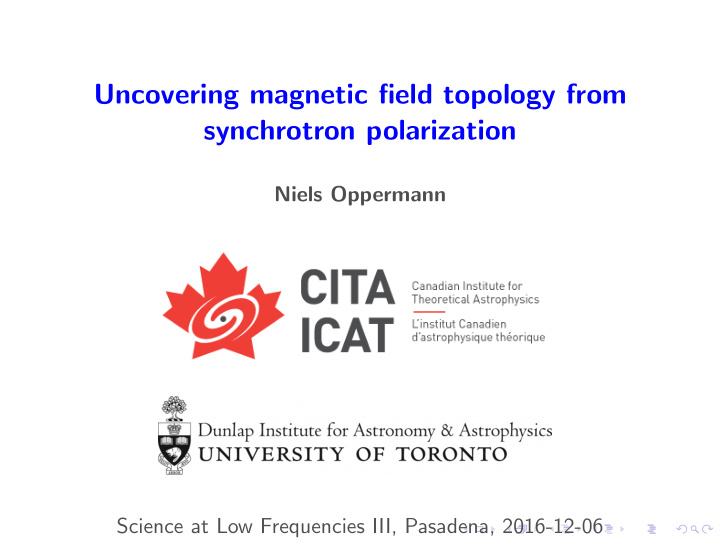



Uncovering magnetic field topology from synchrotron polarization Niels Oppermann Science at Low Frequencies III, Pasadena, 2016-12-06
Multifrequency surveys Many existing / upcoming polarization surveys span large wavelength ranges credit: NRC-CNRC credit: CSIRO e.g.: GMIMS 300 MHz – 1.8 GHz CHIME 400 MHz – 800 MHz GBT intensity mapping survey credit: Andre Renard 700 MHz – 900 MHz 3D data sets credit: NRAO
Magnetic vector field Synchrotron emission is polarized; orientation given by plane-of-sky component of B -field, B ⊥ Faraday rotation depends on line-of-sight component of B -field, B � credit: Planck/ESA B -field : 3D vector at each 3D position multifrequency observations : 3D data sets, sensitive to all three vector components, but only in projection What can(’t) we learn? credit: Wikimedia Commons
Magnetic helicity � d 3 x A · B H = V conserved if: ◮ conductivity high ◮ nothing happens at the surface of V Helicity predicted by all mean-field dynamo models, but details (such as sign) differ.
Detecting magnetic helicity I Helix seen face on: Junklewitz et al. 2011 Oppermann et al. 2011
Detecting magnetic helicity I Helix seen face on: B ⊥ appears circular polarization appears radial (in the absence of Faraday rotation) Junklewitz et al. 2011 Oppermann et al. 2011
Detecting magnetic helicity I Helix seen face on: B ⊥ appears circular polarization appears radial (in the absence of Faraday rotation) B � positive or negative gradient of Faraday depth radial Junklewitz et al. 2011 Oppermann et al. 2011
Detecting magnetic helicity I Helix seen face on: B ⊥ appears circular polarization appears radial (in the absence of Faraday rotation) B � positive or negative gradient of Faraday depth radial To detect helicity, look for preferred alignment of P and ∇ φ Junklewitz et al. 2011 Oppermann et al. 2011
Detecting magnetic helicity II Helix seen face on: polarization at different distances appears at different angles, thus depolarization but resonance between scale of helicity and wavelength possible, thus repolarization depends on sign of helicity Brandenburg et al. 2014 Horellou et al. 2014 Volegova et al. 2010
Detecting magnetic helicity II Helix seen face on: polarization at different distances appears at different angles, thus depolarization but resonance between scale of helicity and wavelength possible, thus repolarization depends on sign of helicity Brandenburg et al. 2014 Horellou et al. 2014 Volegova et al. 2010
Detecting magnetic helicity II Helix seen face on: polarization at different distances appears at different angles, thus depolarization but resonance between scale of helicity and wavelength possible, thus repolarization depends on sign of helicity Brandenburg et al. 2014 Horellou et al. 2014 Volegova et al. 2010
Detecting magnetic helicity II Helix seen face on: polarization at different distances appears at different angles, thus depolarization but resonance between scale of helicity and wavelength possible, thus repolarization depends on sign of helicity Brandenburg et al. 2014 Horellou et al. 2014 Volegova et al. 2010
Detecting magnetic helicity II Helix seen face on: polarization at different distances appears at different angles, thus depolarization but resonance between scale of helicity and wavelength possible, thus repolarization depends on sign of helicity Brandenburg et al. 2014 Horellou et al. 2014 Volegova et al. 2010
Detecting magnetic helicity II pos. helicity neg. helicity Brandenburg et al. 2014
Detecting magnetic helicity III What if positive and negative helicity on different scales? ◮ Estimate power spectrum for positive and negative helical component of the B -field ◮ Proper estimate (with uncertainty) requires marginalization over B -field realizations ◮ lots and lots of parameters. . .
Summary ◮ Inferring exact 3D B -field without strong assumptions impossible ◮ But statistical quantities may be accessible ◮ Helicity can teach us about the Galactic dynamo ◮ Has specific signatures in polarization data ◮ There is hope, but assessing significance takes care
Bonus slides
The α -Ω dynamo
The α -Ω dynamo
The α -Ω dynamo
The α -Ω dynamo
The α -Ω dynamo
The α -Ω dynamo
The α -Ω dynamo
The α -Ω dynamo
The α -Ω dynamo ◮ small-scale kinetic helicity leads to B -field growth, twists B -field ◮ leads to small-scale helicity, leads to reduced B -field growth ◮ dynamo gets quenched, unless helicity moved around ◮ expect opposite signs of helicity either in different regions or on different scales
Detecting magnetic helicity I example: positive helicity on all scales Stokes I Stokes Q Stokes U Faraday depth alignment smoothed alignment
Detecting magnetic helicity I example: negative helicity on all scales Stokes I Stokes Q Stokes U Faraday depth alignment smoothed alignment
Detecting magnetic helicity I example: no helicity on all scales Stokes I Stokes Q Stokes U Faraday depth alignment smoothed alignment
Detecting magnetic helicity II If mix of scales, not necessarily a clear resonance But expect (anti-) correlation between Faraday depth and polarization degree Volegova et al. 2010 negative helicity no helicity positive helicity
Recommend
More recommend